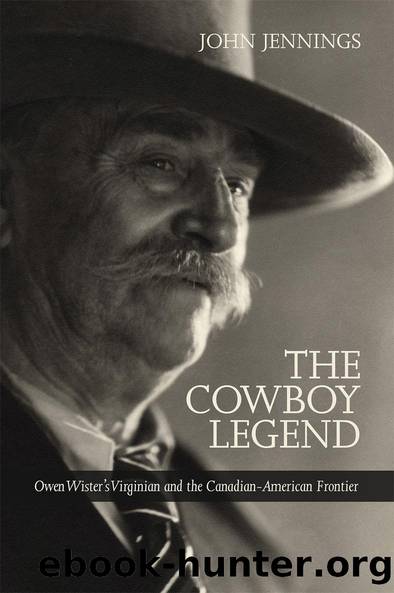The Cowboy Legend by John Jennings

Author:John Jennings [Jennings, John]
Language: eng
Format: epub
Tags: Nonfiction, Social & Cultural Studies, Social Science, Sociology, Rural, History, Americas, North America, Fiction & Literature, Literary Theory & Criticism, American
ISBN: 9781552387528
Publisher: University of Calgary Press
Published: 2015-11-23T05:00:00+00:00
6: Alberta (1888â1904)
In the fall of 1885, shortly after spending the summer escorting Wister, Johnson left Wyoming for Alberta, riding his big black horse, Monte (renamed Sailor in Canada). When he reached Alberta, by way of the old Indian trail that ran practically unbroken from Mexico to Canada, he stopped at the ranch of Joe Trollinger on Mosquito Creek, midway between Fort Macleod and Calgary. He looked over the range and was pleased with what he saw. The grass could support far more cattle than could the Powder River country, the land was well sheltered, and he was told that stock wintered easily in the area, famous for its chinook winds. Besides, a cow worth twenty-five dollars in Wyoming went for forty in Alberta.
Fred Hesse had asked him to scout the Alberta range for good grazing land. By 1885, Moreton Frewen was acutely conscious that northern Wyoming was overstocked and was desperately trying to persuade his board in London that as many cattle as possible should be moved to Alberta. As early as 1883, Frewen, who has come down to us in Wyoming history as the quintessential English twit, was ahead of most in predicting the end of the free range in northern Wyoming.1
Fred Hesseâs reports to Frewen in 1885 undoubtedly reinforced Frewenâs belief that the company was facing a crisis. Hesse estimated the loss of cattle over the previous winter at 15 percent, significantly greater than in previous years.2 The number of calves in 1885 was way down from the previous year, and the 76 herd was down to 48,550 from 55,000. The range in Johnson County was in bad shape from overgrazing. (The earlier refusal of the large ranchers to countenance a lease arrangement was now coming home to roost!) The dividend of the Powder River Cattle Company had been a mere 3 percent in 1884; clearly, some new solution was necessary. So, at roughly the same time that Johnson was looking over the range in Alberta, the shareholders of the 76 sent Dick Frewen in 1885 to look at grazing land in Montana and Alberta. He sent back a glowing report from Fort Macleod, in southern Alberta, and, acting on that report, Moreton Frewen went to Ottawa to pay a visit to his friend Sir John A. Macdonald, prime minister of Canada, to see if the 20 percent import duty on cattle could be waived.3
Typical ranching country of southern Alberta. The chinook winds in winter dropped their moisture in the mountains and often blew enough snow off the range to allow grazing all winter. Glenbow Archives, NA 67-6.
Download
This site does not store any files on its server. We only index and link to content provided by other sites. Please contact the content providers to delete copyright contents if any and email us, we'll remove relevant links or contents immediately.
Nudge - Improving Decisions about Health, Wealth, and Happiness by Thaler Sunstein(7261)
iGen by Jean M. Twenge(5168)
The Fire Next Time by James Baldwin(5032)
Adulting by Kelly Williams Brown(4243)
The Hacking of the American Mind by Robert H. Lustig(4095)
The Sports Rules Book by Human Kinetics(4081)
The Ethical Slut by Janet W. Hardy(4042)
Captivate by Vanessa Van Edwards(3733)
Mummy Knew by Lisa James(3525)
In a Sunburned Country by Bill Bryson(3376)
The Worm at the Core by Sheldon Solomon(3328)
Ants Among Elephants by Sujatha Gidla(3282)
Suicide: A Study in Sociology by Emile Durkheim(2908)
The Slow Fix: Solve Problems, Work Smarter, and Live Better In a World Addicted to Speed by Carl Honore(2846)
The 48 laws of power by Robert Greene & Joost Elffers(2818)
Humans of New York by Brandon Stanton(2694)
Handbook of Forensic Sociology and Psychology by Stephen J. Morewitz & Mark L. Goldstein(2606)
The Happy Hooker by Xaviera Hollander(2586)
The Tipping Point by Malcolm Gladwell(2566)
